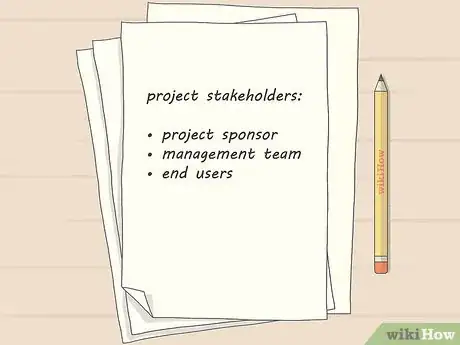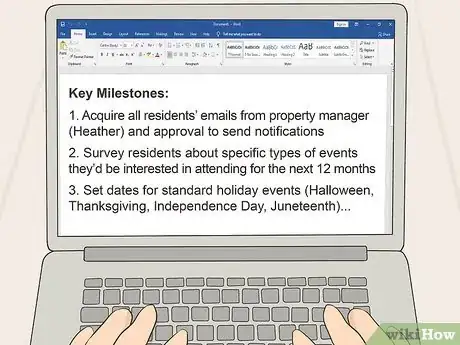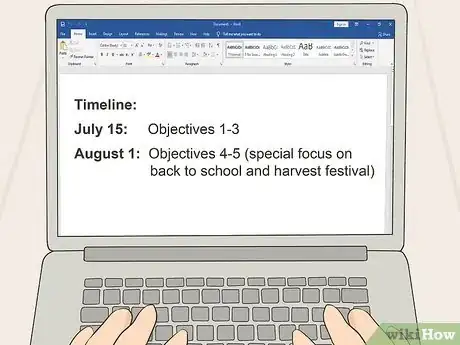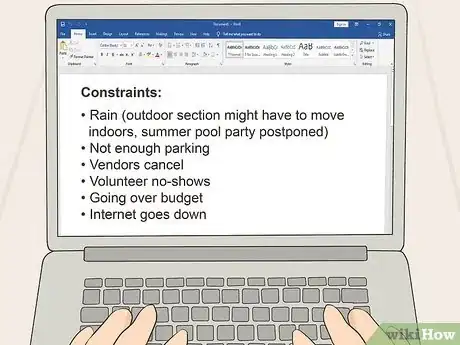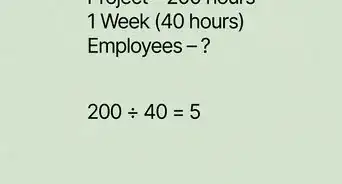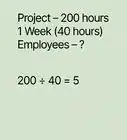X
This article was co-authored by wikiHow Staff. Our trained team of editors and researchers validate articles for accuracy and comprehensiveness. wikiHow's Content Management Team carefully monitors the work from our editorial staff to ensure that each article is backed by trusted research and meets our high quality standards.
This article has been viewed 17,003 times.
Learn more...
A good project plan allows you to present a complete picture of your plan to stakeholders, including the timeline, workflow, and cost estimate. Keep reading to learn more about the in-depth information you should include in your plan!
Steps
Part 1
Part 1 of 3:
Organizing the Project Workflow
-
1Identify all the necessary project stakeholders. A stakeholder is anyone who will be affected by the project. This is a long list of people ranging from the project sponsor down to the individual employees who will work on the project. There are a few stakeholders you should identify and communicate with throughout the process.[1]
- The project sponsor is the person or business that provides the funds for the project. They usually own the end result. Usually the sponsor has to sign off on all big decisions.
- The management team are the ones who oversee the project. Usually each member of the management team heads a division that carries out specific tasks to complete the project.
- End users are people who will use the project when it's finished. Visitors to a building, for example, are end users. You usually don’t meet with end users, but you should take their potential concerns into account while planning the project.
-
2Meet with the upper-level stakeholders to work out the project's goals. In this pre-planning stage, work out a clear definition of the project goals by speaking with its stakeholders. You don’t have to meet with every stakeholder, since many are lower-level employees. But you should speak with stakeholders at the management and ownership levels. You’ll have to meet their expectations with this project.[2]
- Speak with the project sponsor to understand their expectations and work out the project goals. Begin by consulting with them.
- Meet with the management team before drawing up concrete plans to understand the budget, timeline, necessary resources, and risks of the project. If the managers bring up any concerns about the project, take them seriously. They are the ones who have to carry the project out and can identify potential problems.
Advertisement -
3Define the project’s scope to plan how you will complete it. The scope is the intended result of the project. What will this project accomplish when it’s completed? What objectives will it meet? Having a clear idea of the project’s scope is crucial for planning what steps you’ll take to meet those goals. In speaking with the important stakeholders, get an understanding for what the intended project scope is.[3]
- For instance, a project scope could be building a new luxury apartment building. All the subsequent planning will build towards this end result.
- Make sure the project scope is feasible. For example, if a sponsor wants to travel to Mars next year, this is probably not a manageable scope. Talk with the sponsor and inform them of what is currently possible, and then work out a scope you can meet.
- If the sponsor is not entirely sure what the intended scope for the project is, help them work it out. Speak with them and the project managers to come to a conclusion on what the end result should produce.
-
4Divide the project into key milestones. Once you’ve defined the scope, you can identify the milestones the team has to meet. Milestones are large tasks that progress chronologically. When one milestone is met, another begins.[4]
- If the goal is building an apartment building, important milestones would include purchasing the land, getting the building permits, laying the building foundation, constructing the frame, and so on until the building is completed. Identify all necessary milestones like these.
- List the milestones in the order they have to be done. For example, you can’t lay the foundation until you have construction permits. Keep your project flow organized like this.
-
5Draw clear lines of communication between project stakeholders. Communication is crucial during the entire project process. Different people and departments should have clear lines of communication so every manager is informed of the project’s progress. Before you even start writing the project plan, identify who is in charge of each task and who reports to whom. This will help your team run much more smoothly so they can complete the project on time.[5]
- Part of this workflow is making sure people aren’t bothered with problems that aren’t in their department. For example, the person responsible for landscaping around the building doesn’t need to know if there was an issue with the phone lines in the building, so they shouldn’t be contacted if such a problem occurs.
- Plan on writing this communications workflow in your project plans so all participants know who to contact if they need information.
Advertisement
Part 2
Part 2 of 3:
Researching the Budget and Schedule
-
1Break milestones into substeps to estimate the cost and schedule. Estimating costs and timelines is difficult for large tasks. Each milestone you identify is too large for an accurate cost and schedule estimate. Divide milestones further into more substeps for completion. Then develop timelines and budgets for each substep.[6]
- If one milestone is “Lay the building foundation,” there are many substeps involved there. You have to contact potential contractors, get price quotes from them, choose a company, excavate the land, pour the concrete, and so on. Account for each of these substeps when making your estimate.
-
2Estimate the cost of each substep to calculate the total project cost. With your milestones broken down into substeps, developing a cost estimate will be much easier. Take each individual substep and research its potential cost. Then use this information to develop an estimate for the total project cost.[7]
- If you're calculating the cost for the "Lay the foundation" milestone of an apartment building, the costs to account for include the price of concrete and other materials, the permits for pouring concrete, and the labor cost for the work. Research the average cost of each step to develop a cost estimate. Use the most up-to-date information you can find so your figures are accurate.
- If your company has analysts who have worked on these projects before, consult with them on these costs. It’s their job to account for project costs.
- Break your cost estimate into several different forms. Draw up a total project cost, cost per milestone, and cost per month or quarter. Project sponsors need this information to adjust their expectations and financing.
-
3Determine which substeps are dependent on each other. All projects have some steps that can’t be completed until a previous step is done, which impacts the project timeline and schedule. These steps are dependent on each other, and a delay on dependent steps delays the whole project. Other steps are independent, and aren’t necessarily reliant on other steps being completed first. Identify all the substeps that are dependent on each other to develop an accurate calendar for the project.[8]
- For example, a new building requires construction permits. This means that no work can start until you get these permits, and all other steps are dependent on this step.
- Once construction starts on an apartment, you can’t start wiring the building until the foundation is constructed. However, you can start doing the landscaping outside while you wire the building, so these two tasks aren’t dependent on each other.
-
4Develop a timeline for each milestone. Just as you broke down each milestone into substeps to estimate the cost, do the same to develop a timeline. Research the normal amount of time needed for each substep. Use this information to develop a timeline for each milestone, and finally for the whole project.[9]
- Take the planning stage into account as well. For instance, building permits in your city may take 6 months to process. That means no construction can start for at least 6 months.
- While you're waiting for the permits, however, you can start negotiating with construction companies. Then when the permits come through, all the agreements are in place for work to start. Identify steps like these than can happen simultaneously to speed the process.
- When estimating project timelines, it’s often best to overestimate a bit. This way you have breathing room if there are any unexpected problems.
-
5Name any potential risks that could impact the project. All projects involve certain risks that stakeholders should be aware of. These can range from scheduling delays to permit problems that could endanger the whole project. While researching the budget and schedule, identify all the risks this project could face. If possible, present suggestions that could overcome these setbacks.[10]
- For example, if you’re planning a building project, one potential risk is the price of raw materials going up and impacting the project budget. You might propose that working fast is the best option for avoiding this risk. Alternatively, you could propose buying certain materials ahead of time and storing them so the project doesn’t encounter unexpected price increases.
Advertisement
Part 3
Part 3 of 3:
Presenting Your Project Plan
-
1Demonstrate how the plan addresses your sponsor’s expectations. The main person or people you have to impress with the project plan is the sponsor. If they like your plan, they’ll go ahead with the project. If not, they could end up pulling out and you could lose a lot of money. Begin by addressing how this plan accomplishes the project scope.[11]
- Use clear, simple language when explaining your plan. Avoid jargon as much as you can so there are no miscommunications and everyone is on the same page.
- Clear statements like, "I will show you the three ways that this plan accomplishes our project goals," convey your message best.
-
2Explain your process for developing the budget and timeline. Sponsors and managers will want to know how you came up with your estimates. Be ready to briefly explain your procedure. While explaining, name any potential variables or risks that could impact these projections, and how the project might account for them.[12]
- You don’t have to go through every calculation you made. Start by presenting the estimate for each milestone, and give a summary of how you reached that conclusion. If anyone wants more information, be prepared to go into more detail.
- Be concise and direct when explaining the budget. For example, state, "I've calculated a total budget of $15 million for this project. This includes $7 million for material costs, $1 million for permits, $5 million in labor costs, and $2 million in land purchases. I developed these estimates by researching the normal expenses for construction in this area last year. I'm happy to explain these calculations further if anyone wants more detail."
-
3Provide a complete copy of the project plan to all stakeholders. You won’t be reading the entire project plan word for word in the meeting, and some stakeholders may want more information. Provide a full copy of your report to each stakeholder, either electronically or on paper. Allow them enough time to review it and get back to you with suggestions.[13]
- If your team has a shared cloud folder or uses a communication software, upload the plan here. Also print off some paper copies to bring to the meeting.
- Your stakeholders may want a summary of the information without the entire report. Provide a handout that hits all the major points in your plan.
-
4Ask for feedback and revisions. Revising the project plan is a normal part of the process. It’s likely that at least one stakeholder will have suggested changes to the project plan. Ask the team for feedback or criticisms. If someone suggests a change, bring it up with the whole team. If they agree, make the revision to the plan.[14]
- Stating, "I'm confident that I've been comprehensive with this project plan, but I welcome any feedback or suggestions," shows that you're happy with the plan you produced but are flexible enough to work with a team as well.
- Take concerns from project managers seriously. They are the ones who have to carry the project out, and if they think one of your estimates is unrealistic you should consider revising it.
Advertisement
Community Q&A
-
QuestionWhat software is helpful to make a project plan?
 TroyvitCommunity AnswerYou can use the software that you're most comfortable with as a starting point. You could build most of a project plan in a word processor using a spreadsheet to hold your numbers, track the people, and even establish timelines. That said more specialized (and expensive tools) like Trello, monday.com and Asana have a lot of bells and whistles to help keep you organized. In the end though you'll have to build a presentation you can share with people and that takes you back to office products like GSuite, etc. There are many open source tools you can use as well like Restyaboard, Nextcloud, OnlyOffice, LibreOffice, etc.
TroyvitCommunity AnswerYou can use the software that you're most comfortable with as a starting point. You could build most of a project plan in a word processor using a spreadsheet to hold your numbers, track the people, and even establish timelines. That said more specialized (and expensive tools) like Trello, monday.com and Asana have a lot of bells and whistles to help keep you organized. In the end though you'll have to build a presentation you can share with people and that takes you back to office products like GSuite, etc. There are many open source tools you can use as well like Restyaboard, Nextcloud, OnlyOffice, LibreOffice, etc.
Advertisement
References
- ↑ https://www.projecttimes.com/articles/10-steps-to-creating-a-project-plan.html
- ↑ https://www.projecttimes.com/articles/10-steps-to-creating-a-project-plan.html
- ↑ https://www.projecttimes.com/articles/10-steps-to-creating-a-project-plan.html
- ↑ https://www.pmi.org/learning/library/milestone-different-planning-approach-7635
- ↑ https://www.projecttimes.com/articles/10-steps-to-creating-a-project-plan.html
- ↑ https://www.projecttimes.com/articles/the-project-plan-how-much-detail-is-enough.html
- ↑ https://www.projecttimes.com/articles/the-project-plan-how-much-detail-is-enough.html
- ↑ https://www.projecttimes.com/articles/10-steps-to-creating-a-project-plan.html
- ↑ https://www.projecttimes.com/articles/10-steps-to-creating-a-project-plan.html
- ↑ https://pm4id.org/chapter/11-1-defining-risk/
- ↑ https://www.usability.gov/how-to-and-tools/methods/kick-off-meeting.html
- ↑ https://www.usability.gov/how-to-and-tools/methods/kick-off-meeting.html
- ↑ https://www.projecttimes.com/articles/10-steps-to-creating-a-project-plan.html
- ↑ https://www.projecttimes.com/articles/10-steps-to-creating-a-project-plan.html
About This Article
Advertisement
